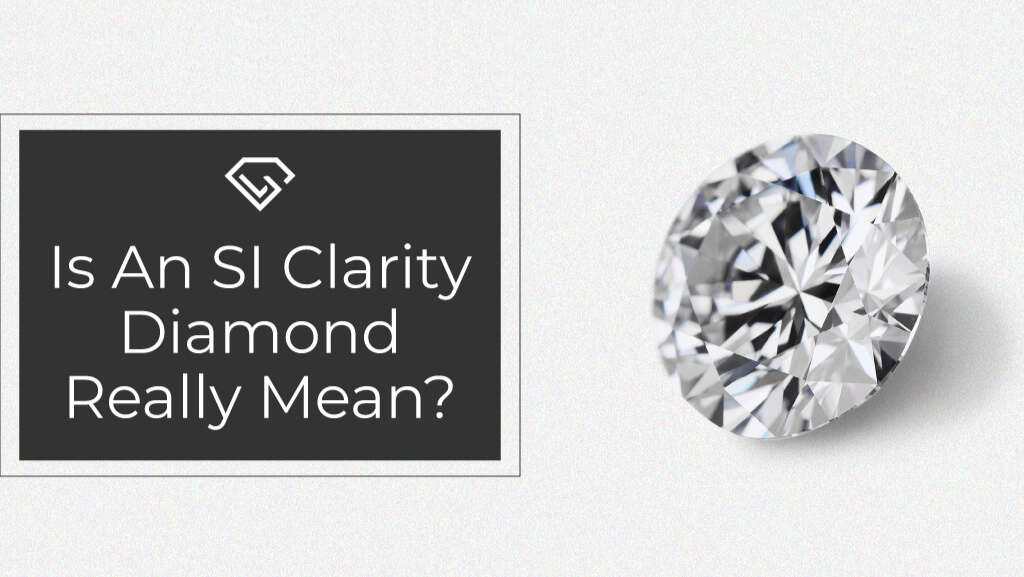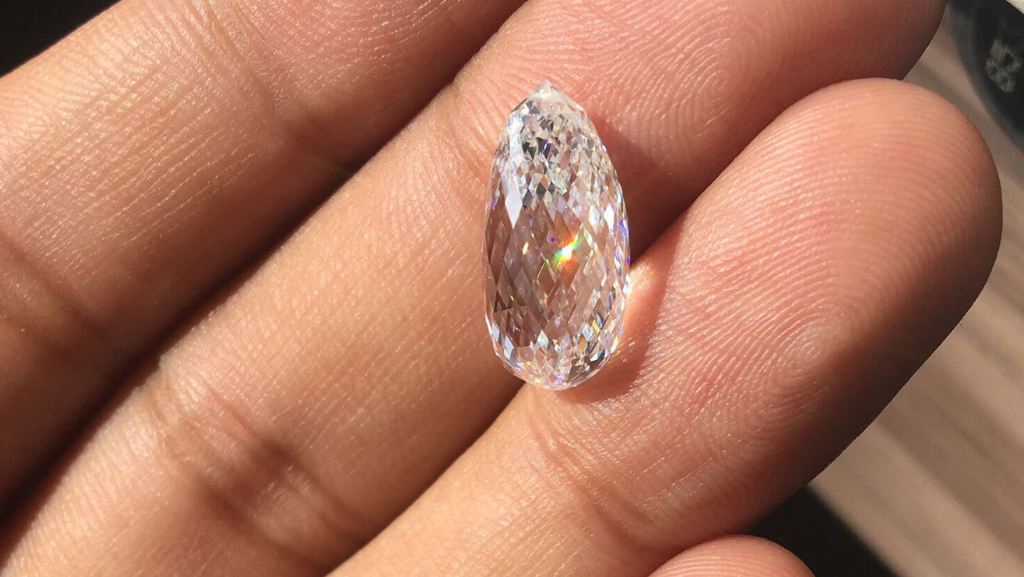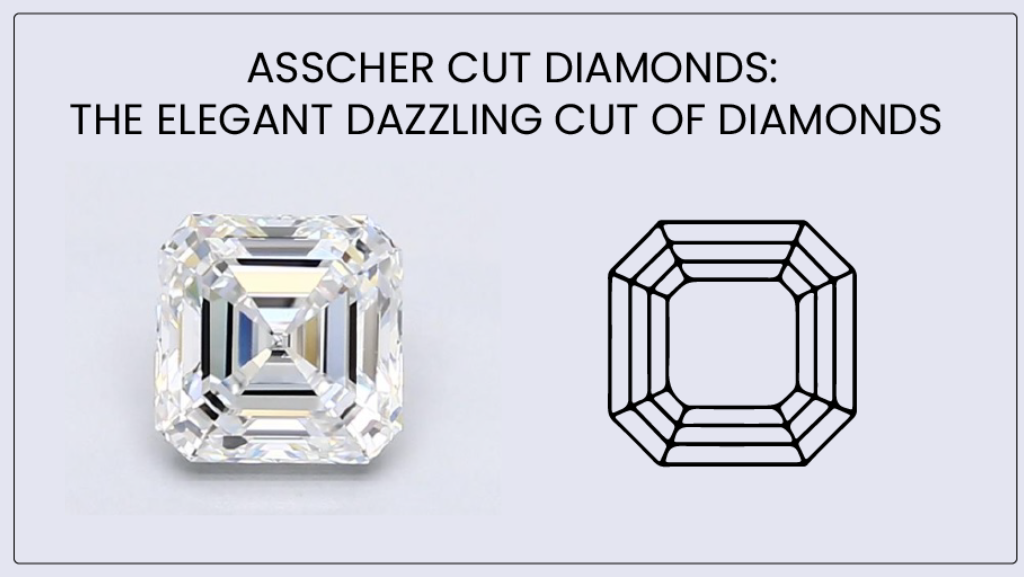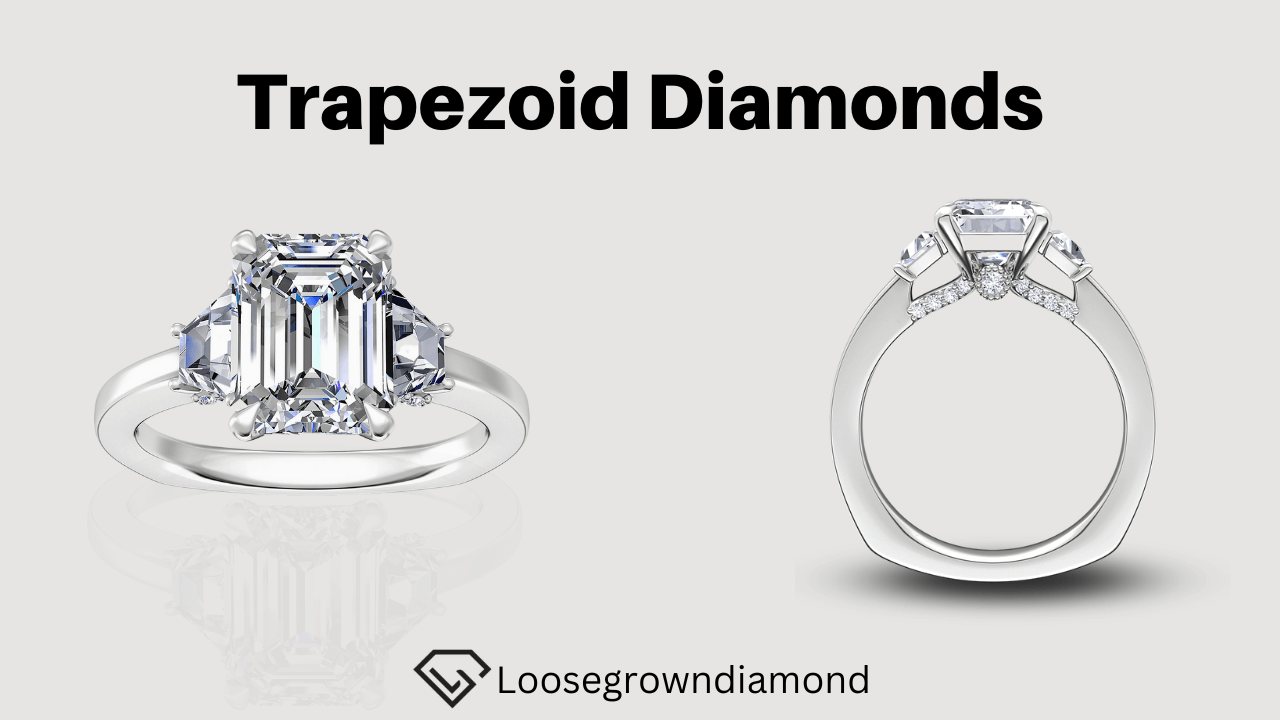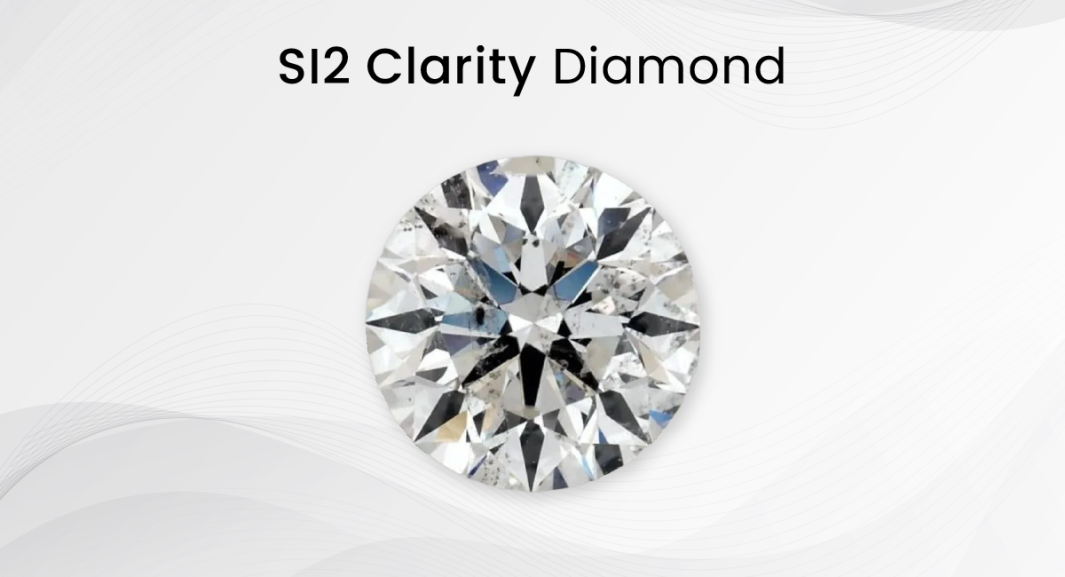Pear Cut Diamonds vs Marquise Cut Diamonds – Which One Will Make Your Fingers Look Pretty?
The charm and attraction that diamonds have make it one of the most precious stones. Additionally, diamonds’ brightness and durability make them symbols of sophistication and are valued for their adaptability in numerous types and settings. Lab created diamonds are ideal for engagement rings and other meaningful jewelry because they symbolize love and devotion.
The beauty of it is so versatile that it can blend into any outfit and occasion so blissfully that it would appear like a match made in heaven. Diamonds do not subdue their beauty but enhance themselves while complimenting others perfectly. This strongest object on the earth is known for its stunning ability to transmit light and radiate in its full glory.
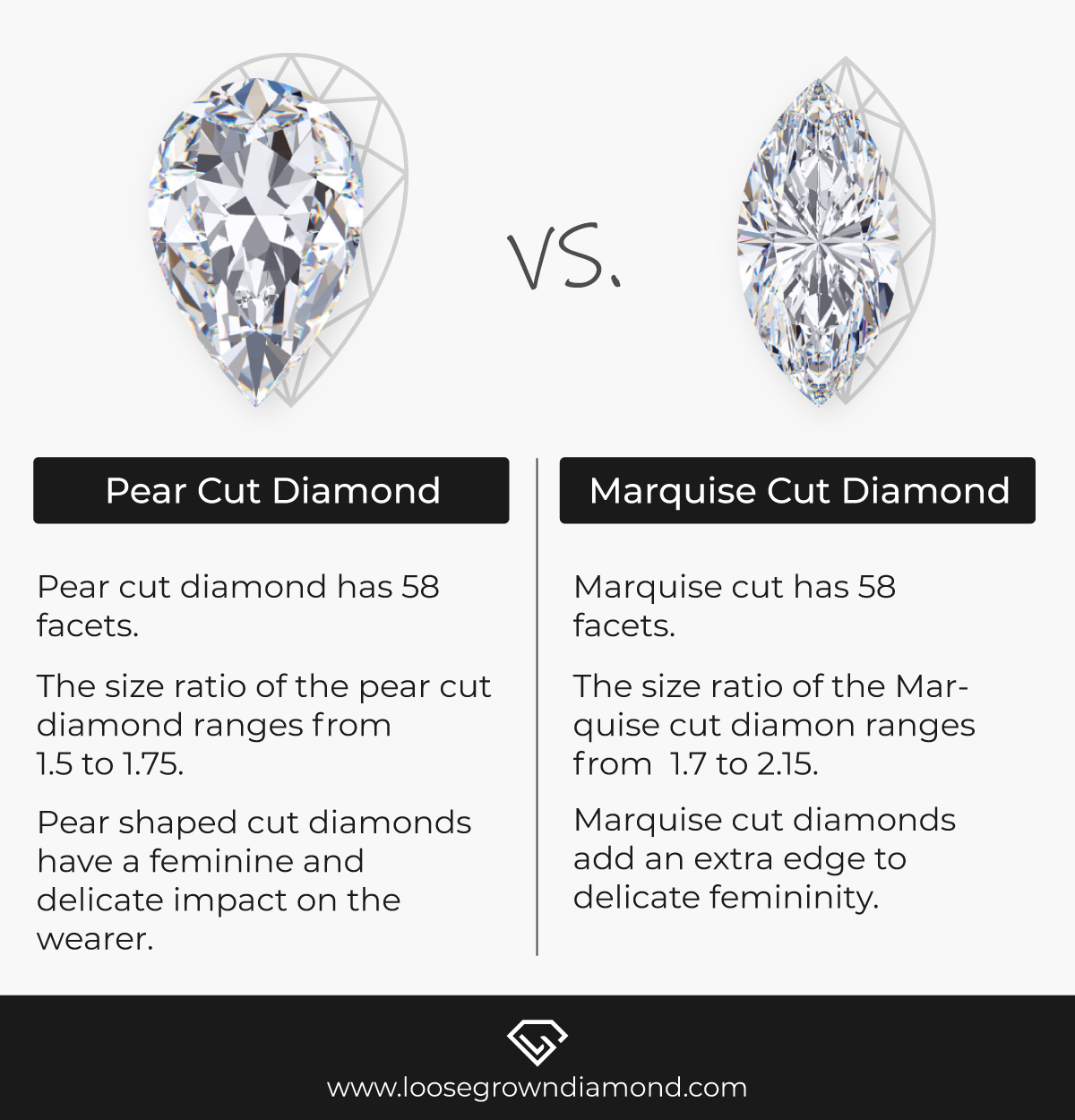
This ability of the diamond to transmit light efficiently is based on the intricate craftsmanship which is indicated by the cuts provided to the diamond. The most important factors for selecting a diamond are based on the 4 C’s- cut, color, clarity, and carat. Out of these diverse factors, the cut is the most important factor as this helps to enhance the brilliance of the diamond.
Pear Cut diamonds Vs Marquise Cut Diamonds
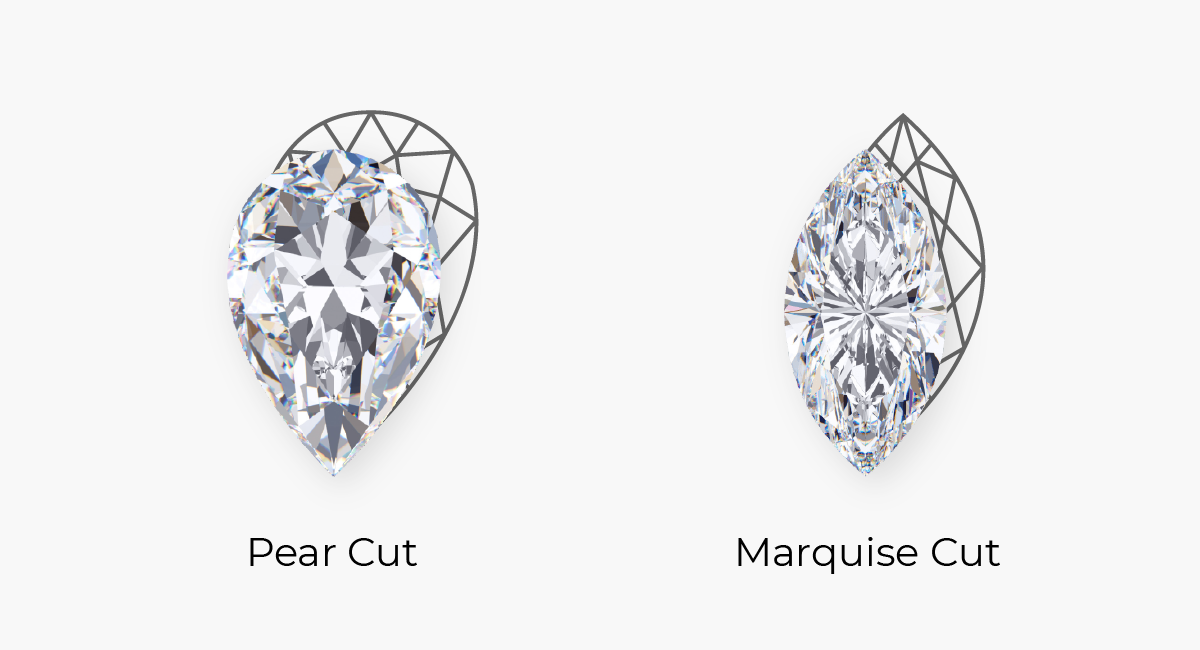
With 58 facets apiece, the pear and marquise cuts exhibit a unique grace. The pear exudes femininity with its lovely curves and delicate tapering; its ideal length-to-width ratio is 1.50 to 1.75.
On the other hand, the marquise cut, which has an optimal ratio of 1.75 to 2.25, exudes a regal femininity due to its elongated shape and pointy tips.
With their brilliant cuts, one can choose between the strong, eye-catching attractiveness of the marquise and the delicate refinement of the pear.
Their shapes—the marquise’s stretched majesty and the pear’s teardrop grace—offer a distinctive aesthetic for customized beauty.
The cuts which are provided to the lab diamond are generally the facets that are cut, to give the diamond a form, and through which the light will be reflected in an apt manner. The cut states dimensions and symmetry as well.
The intricacy with which the lab created diamond is cut marks exactly how brilliantly it sparkles. The more precise and intricate cut provided, the more efficiently it transmits light, thus appearing more bright and more magnificent.
We can distinguish the better cut, by comparing which diamond reflects more white and colorful light, in contrast to a lesser intense light and color.
There are three factors that determine the brilliance of a perfectly cut lab diamond. Brightness, fire, and scintillation.
- Brightness within a diamond is termed as the internal reflection of light to such an extent that when viewing the diamond from the outside, a sparkle can be seen. The sparkle is directly proportional to the brightness of a diamond.
- Fire is the characteristic of a diamond when a single beam of light scatters into its constituent colors.
- Scintillation is the amount of sparkle in the diamond characterized by the presence of light and dark spots in the diamond that occurs due to the internal reflections of light.
The most important factor in the beauty of a diamond depends on the intricacy of the cut of the diamond.
There are various types of cuts in lab created diamonds like- Round Brilliant (the most common), Pear cut, Marquise cut, Oval cut, Princess-cut, Cushion cut, Emerald cut, Radiant cut, and Asscher-cut diamond.
Pear Cut Diamond History
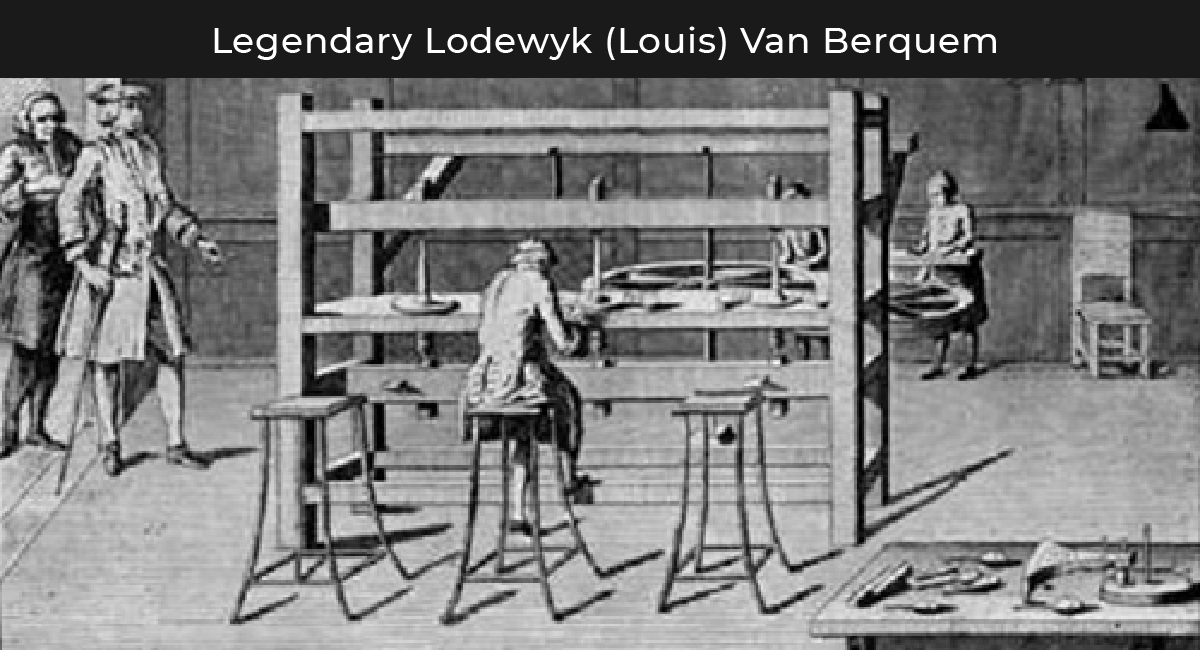 Pear cut was invented by a diamond cutter, who had coincidentally also inverted the diamond polishing wheel.
Pear cut was invented by a diamond cutter, who had coincidentally also inverted the diamond polishing wheel.
This invention of the wheel was definitely a turning point in the history of diamonds, as it enabled the user to make complex diamond cuts and designs with more ease than before. After that, he moved on to introduce pear cut diamonds.
What are Pear Cut Diamonds?
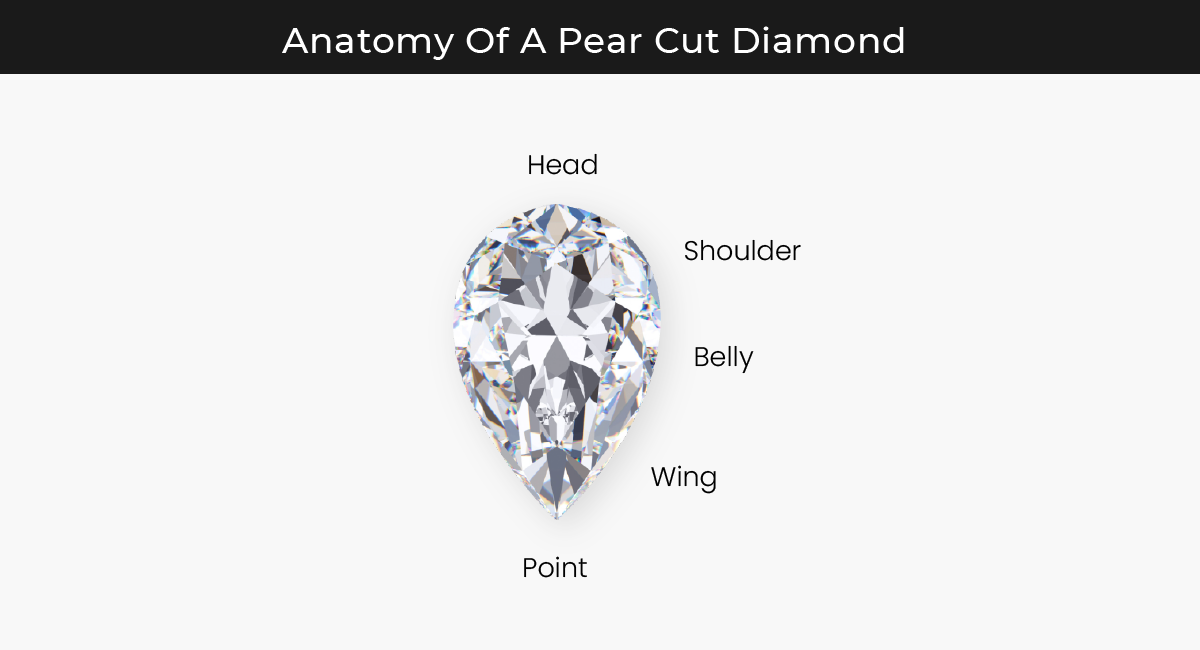
In 1475, Flemish diamond cutter Lodewyk van Bercken revolutionized diamond cutting with the invention of the polishing wheel. This led to the creation of the world’s first pear shape diamond, boasting 58 facets for optimal sparkle.
Over 500 years later, the pear cut remains unchanged, a testament to its enduring brilliance and Van Bercken’s pioneering craftsmanship.
Thinking of a timeless classic piece of jewelry, this ageless cut is the one that crosses the mind. The beauty of this cut really does transcend time and takes us back to the romantic vintage ages. It is shaped in a combination of the round brilliant cut and the marquise cut.
The bottom is curved and enlarged, while the top is pointed into a tip, representing a teardrop. The teardrop shape symbolizes sensitivity. This sensitivity is the gist of the connection of emotions. Hence, the characterization of a romantic symbol.
Shape
Carat
Cut
Color
Clarity
Price
pear
1.00
Ideal
E
VS1
$458 $327
View
pear
1.03
Ideal
D
IF
$1176 $840
View
pear
1.03
Ideal
D
VVS2
$490 $350
View
pear
1.66
Ideal
E
VVS1
$1027 $978
View
pear
1.00
Ideal
E
VS2
$595 $446
View
pear
1.15
Excellent
E
VS1
$673 $505
View
pear
1.06
Ideal
E
VVS2
$556 $417
View
pear
1.02
Ideal
D
VVS2
$549 $412
View
pear
1.52
Ideal
E
VS1
$1245 $934
View
pear
1.04
Ideal
F
VS1
$627 $470
View
pear
1.00
Ideal
G
VS1
$552 $414
View
pear
1.70
Excellent
G
SI2
$807 $605
View
pear
1.05
Ideal
I
VS2
$461 $346
View
pear
1.15
Excellent
F
VVS1
$804 $603
View
pear
1.53
Ideal
G
VS2
$808 $606
View
pear
1.51
Ideal
G
VS1
$899 $674
View
pear
2.19
Ideal
H
VS1
$1380 $1035
View
pear
2.30
Ideal
H
VS1
$1267 $950
View
pear
1.03
Excellent
F
VVS2
$629 $472
View
pear
1.17
Ideal
F
VS1
$777 $583
View
Marquise Cut Diamond History
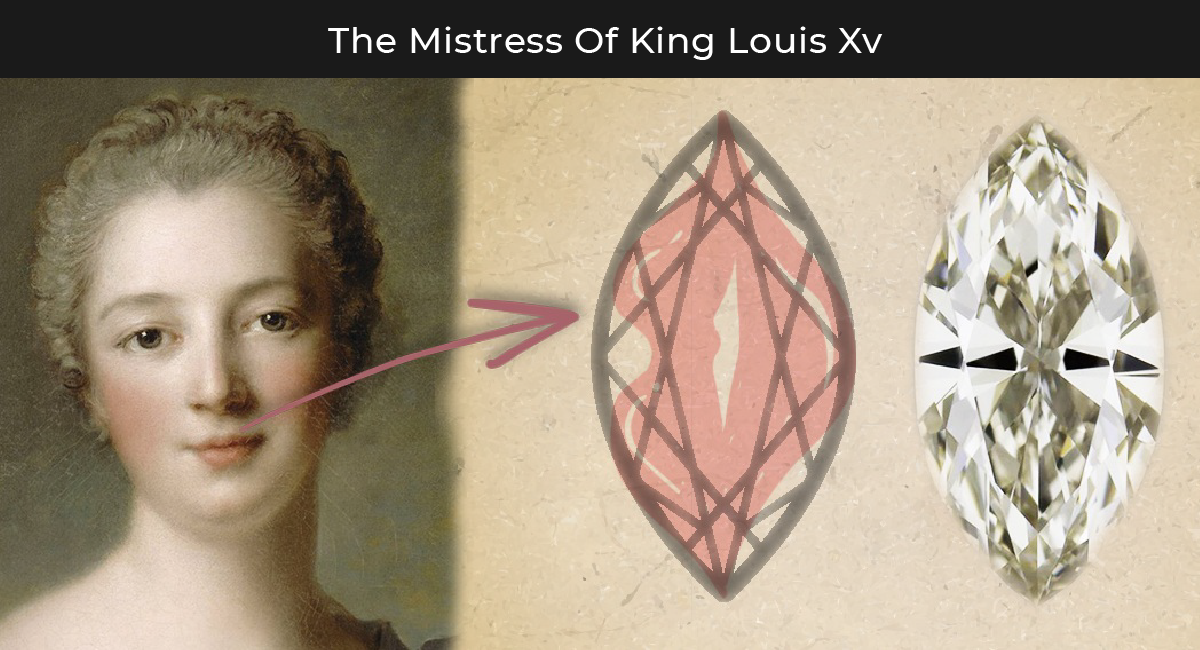
The Marquise cut diamond has a long royal history that dates back to the 18th century in France. It was created from a design that was inspired by King Louis XV’s adoration for the Marquise de Pompadour’s flawless lips.
Over time as we see, the shape of the marquise cut evolved into the design it currently is. Over the span of time, we observe that it began to be called marquise after the rank below the duke.
What are Marquise Cut Diamonds?
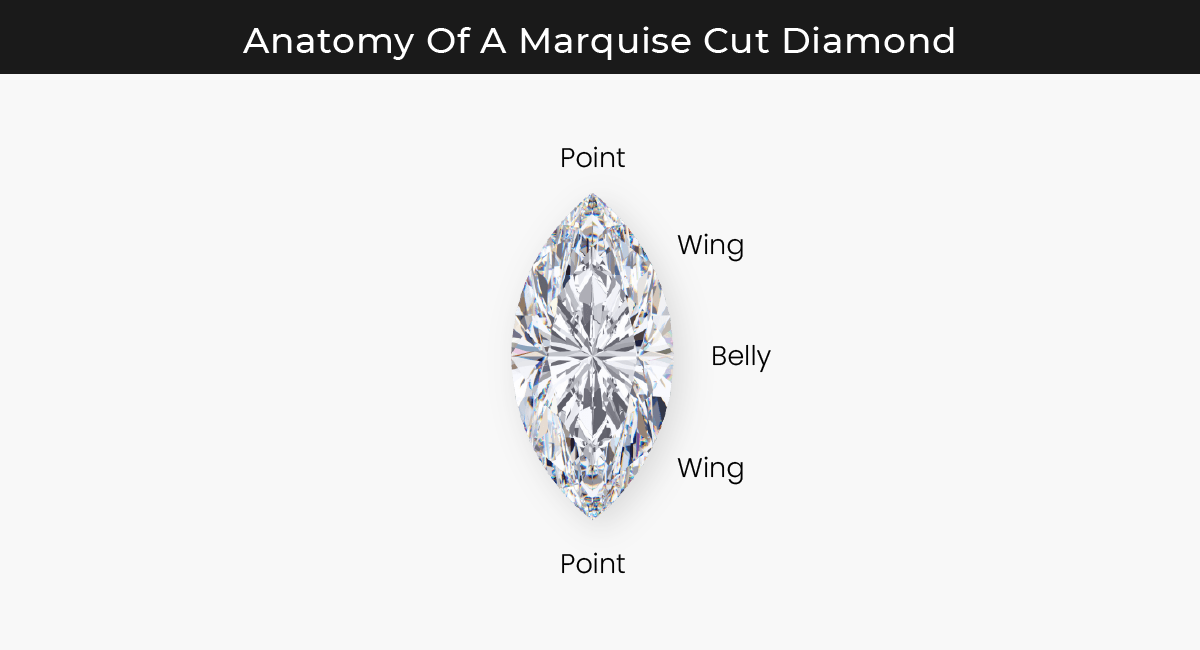
Marquise diamonds are another dramatic cut that exudes elegance in their rarity. The shape of this cut represents a boat some may say, while for others it represents an eye. This cut has 58 facets, defining the shape. Although it is not such an obvious selection for any individual, a quirky visioned person may love it to absoluteness.
Typically this elongated stone has 56 facets defining its shape, and either side results in the characteristic pointed tip of the gem. This feature of the stone also makes it appear larger than the conventional size of similar carat weight diamonds.
Its classic elegance is still valued by contemporary consumers, hence making marquise diamond engagement rings a very popular option today.
Shape
Carat
Cut
Color
Clarity
Price
marquise
1.03
Ideal
E
VVS2
$599 $428
View
marquise
1.92
Ideal
D
VVS2
$2032 $1935
View
marquise
1.93
Ideal
G
SI1
$699 $666
View
marquise
1.09
Ideal
D
IF
$3513 $2635
View
marquise
1.56
Ideal
E
VVS2
$2248 $1686
View
marquise
1.58
Ideal
D
VS1
$2607 $1955
View
marquise
1.53
Ideal
D
VVS2
$2777 $2083
View
marquise
1.55
Ideal
E
VVS1
$2496 $1872
View
marquise
1.54
Ideal
D
VVS2
$2793 $2095
View
marquise
1.10
Ideal
E
IF
$2473 $1855
View
marquise
1.01
Ideal
D
IF
$3264 $2448
View
marquise
1.01
Ideal
E
VS1
$683 $512
View
marquise
1.00
Ideal
F
SI1
$440 $330
View
marquise
1.57
Ideal
D
IF
$8656 $6492
View
marquise
2.26
Ideal
E
IF
$13500 $10125
View
marquise
1.01
Ideal
E
VS1
$675 $506
View
marquise
1.00
Ideal
E
VVS2
$700 $525
View
marquise
1.07
Ideal
F
VVS1
$760 $570
View
marquise
1.08
Ideal
F
VVS1
$767 $575
View
marquise
1.06
Ideal
D
VVS1
$899 $674
View
What is the Difference Between a Diamond Cut and a Diamond Shape?
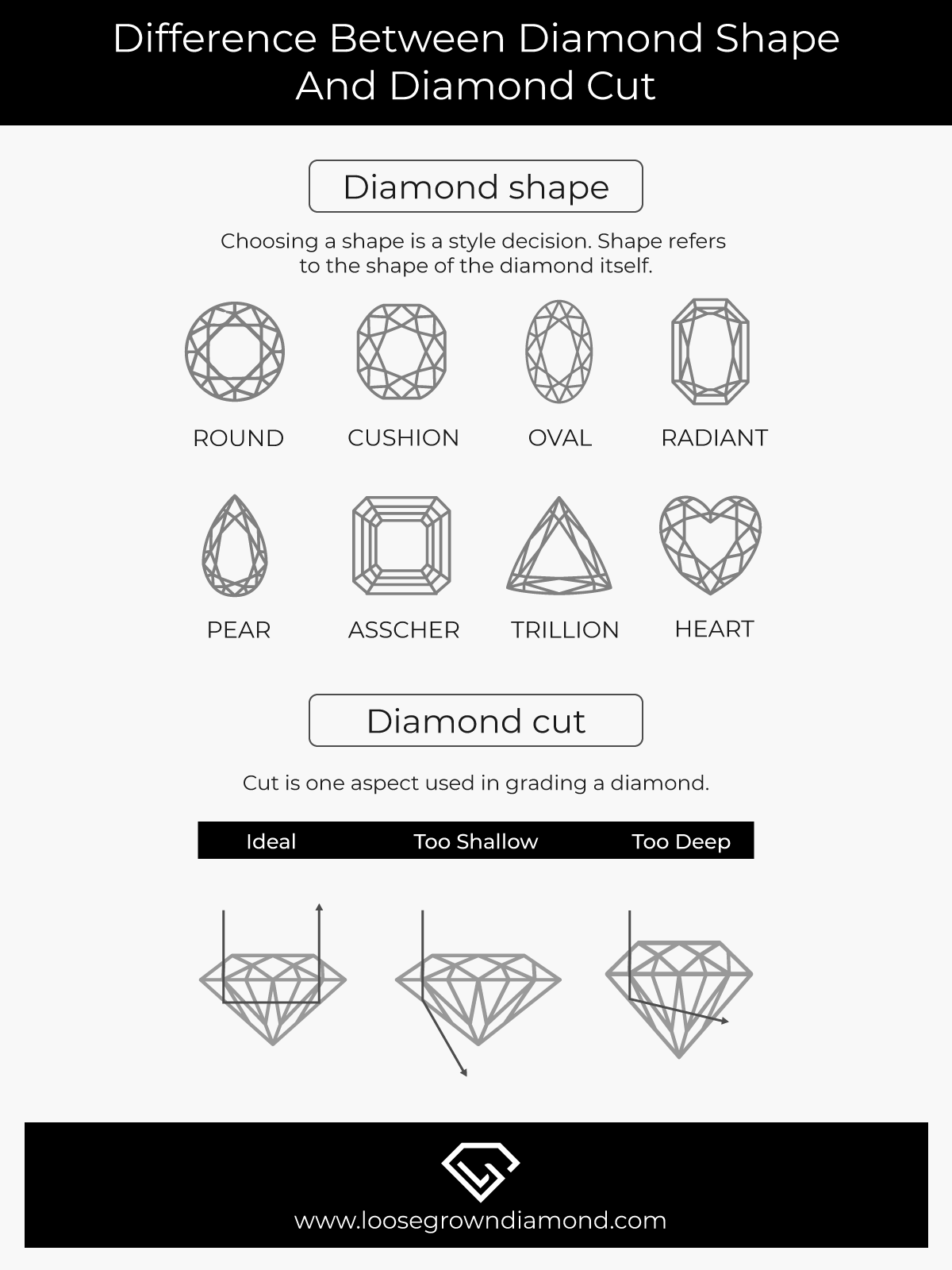 A diamond shape and a diamond cut are two various things, which are often confused. The shape or form is anything that depicts the outline of an object, here is the diamond. The shapes range from round brilliant, pear, cushion shapes, etc.
A diamond shape and a diamond cut are two various things, which are often confused. The shape or form is anything that depicts the outline of an object, here is the diamond. The shapes range from round brilliant, pear, cushion shapes, etc.
The cut of the diamond is anything that would affect the brilliance of the gem. The exact size of the diamond is determined by its cut. Utilize this diamond size chart for a comprehensive guide to determining your size. This is affected by the number of facets, the symmetry achieved by the craftsman, the dimensions of the gem, and finally the reflective quality.
In essence, the difference can be summarized as follows:
- Diamond shape denotes the outer form (e.g., round, heart), influencing aesthetics and symbolism. In contrast, diamond cut involves precision, affecting brilliance through facets, symmetry, and polish.
- Reflectivity, symbolism, and light interaction vary, with shape emphasizing uniqueness, and cut determining luminosity.
- Examples like round and brilliant cuts showcase their specific roles, underlining how the interplay of shape and cut defines the captivating allure of diamonds.
What are the Cut Defects for Pear and Marquise Diamonds?
Pear Cut Defects
In pear cuts, the most prominent problem which persists is the delicacy of the tip. The tip of the diamond is delicate and can lead to chipping over time. Many times it is seen that while creating jewelry out of a pear-cut diamond, the tip gets damaged or becomes blunt which completely ruins the look of the diamond piece.
Another defect that can occur in pear cut diamonds is the asymmetry of the form. Sometimes we can observe that uneven craftsmanship can lead to a form that is asymmetrical and defies the brilliance of the beautiful cut in the diamond. A reason why such hindrances in craftsmanship appear is due to the fact that it is very difficult to achieve the apt level of brilliancy in the cut. The exact dimensions of the crown and pavilion are not known, hence the exact perfect diamond is quite difficult to find.
Marquise Cut Defects
Bowtie- this defect is caused by the elongated shape of the marquise. The bowtie defect refers to a black bowtie-shaped band across the center of the gem. It is always there in the marquise cut, but it can range from very slightly visible to very evident to the naked eye.
Slender football- this defect is, as the name suggests, a thinner version of the actual required size of the diamond. The diamond is slender and the other proportions of the cut too, are not very apt, hence there is a visible reduction in the brilliance of the gem.
Size Ratio of Pear Cut Diamonds vs Marquise Cut Diamonds (Length/Width)
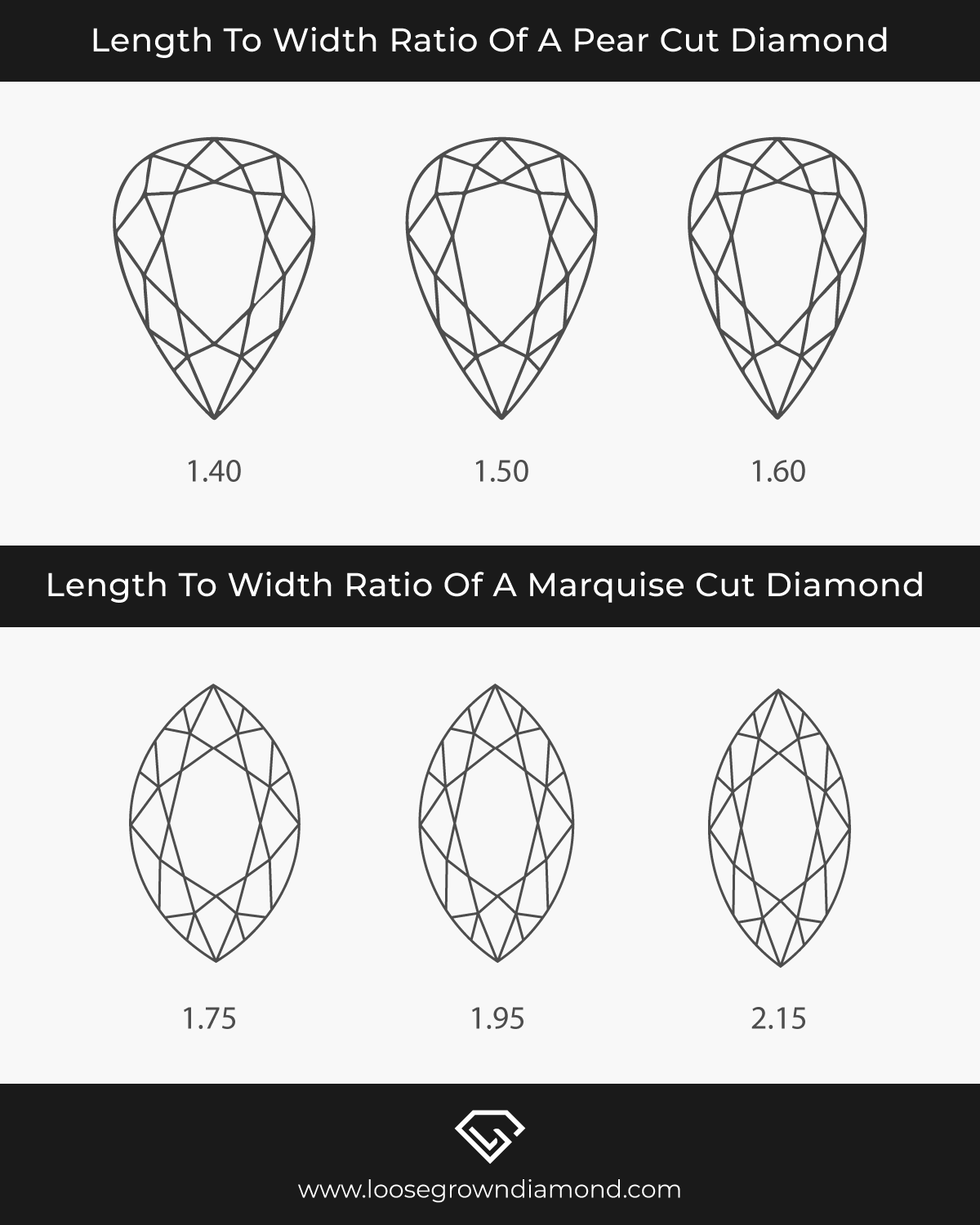
The size ratio of the pear cut diamond ranges from 1.5 to 1.75, of which 1.75 (L/W) comprises the most elegant ones. The classic symbolism of the pear shaped diamond as a teardrop is the reason for it being more preferred in pear shaped diamond engagement rings.
The ideal size ratio of a marquise cut diamond is 1.7 to 2.15, but the ideal ratio is 1.9. Although marquise cut is also an unconventional cut, it is preferred less as compared to a pear shaped diamond.
Pear vs Marquise in Jewelry: Which One Looks Better?
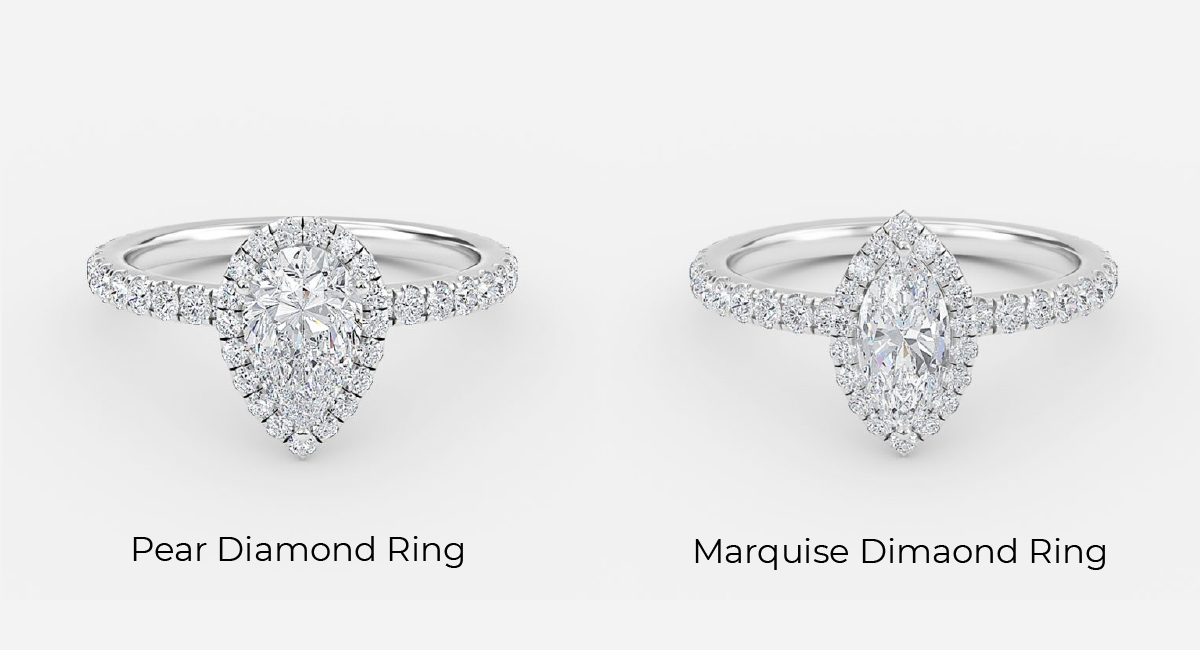
Although the pear and marquise cut can look beautiful in any jewelry, they are preferred more as wedding rings. Hence, engagement rings, anniversary rings, and promise rings are all types of jewelry when paired with a pear shape or marquise shaped diamond that will give an exuberant look.
What Type of Metal Should be Paired with Pear Cut Diamonds?
In the choice of metal, there is a variety, since they look beautiful regardless. A white metal will enhance the diamond, its cut, and the setting. So a white metal like silver, platinum, or white gold, will let the diamond take center stage while supporting its elegance.
A yellow metal like gold will give an antique look to the already antique cut of pear. The yellow of the metal helps subdue any mishap in the quality of the stone.
Rose gold is another unconventional metal, but absolutely romantic and classic. The combination of one romantic aspect of the pink metal with another aspect of the pear cut diamonds just enhances the symbolic aspect of the wedding ring.
What Type of Metal Should be Paired with Marquise Cut Diamonds?
The marquise cut looks absolutely white regardless of the metal it is fixated on. So placing it in yellow or rose-pink metal, will not in any way alter the hue of the diamond. Hence, the marquise looks stunning in all the metals regardless.
Best Pear Cut Diamond Settings
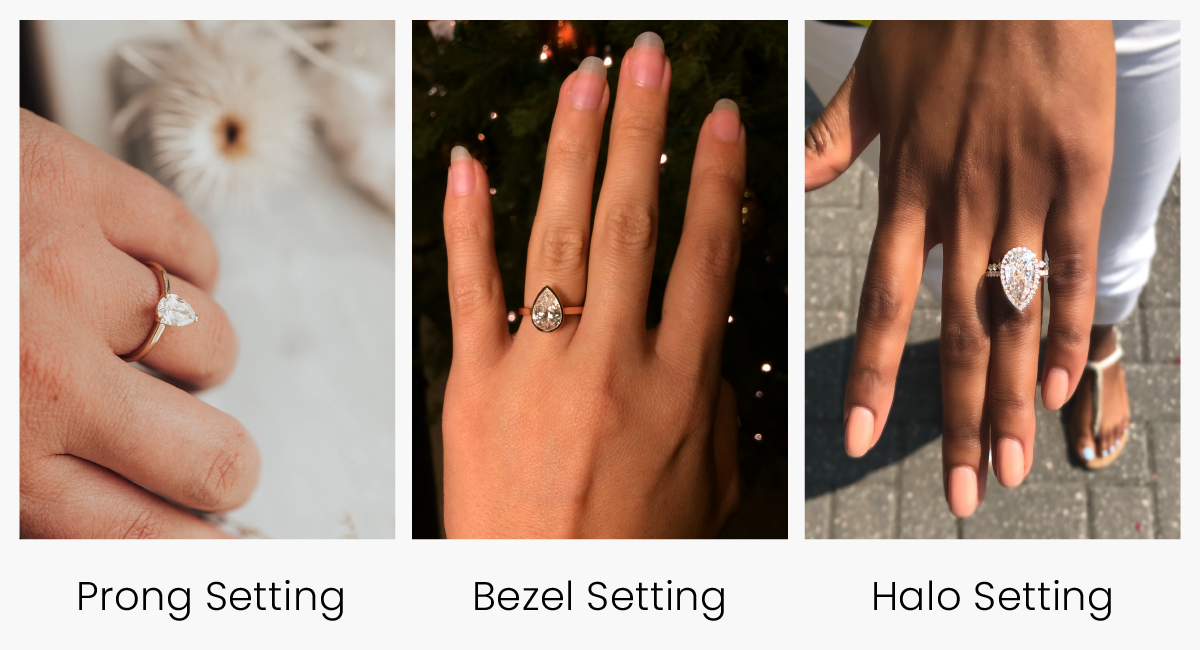
In jewelry, the pear is generally adorned in rings, especially to give an antique feminine edge to the wearer. The diamond can be worn with the tip facing either the hand or the fingers, but it is an absolutely subjective choice. The diamond is delicate and is generally preferred to be fitted in a bezel setting or a halo setting since it provides an extra sense of security.
In a bezel, a metal border contains the gem in place, whereas in a halo, there are one or two lines of smaller diamonds outlining the main diamond. In either of these cases, the tip of the stone will not be projected out as a point and will hence be safe.
A prong is also an option, in which 6 prongs hold the diamond in shape. Three prongs protect the bulge of the pear cut and the tip is taken care of by the remaining 3 prongs. The tip is specially sealed with a v prong so as to protect it from chipping. There are also chances of the tip being hooked onto clothes and fabric, hence the v prong protects against such mishaps.
There is also a 5-prong setting, in which one lower prong has been removed, but the other 5 remain intact in their previous positions. Prong is not the most preferred setting, because the tip can be pointed out, which results in chipping or damage in the long run. The diamond is better when it is absolutely safe in the setting.
Best Marquise Cut Diamond Settings
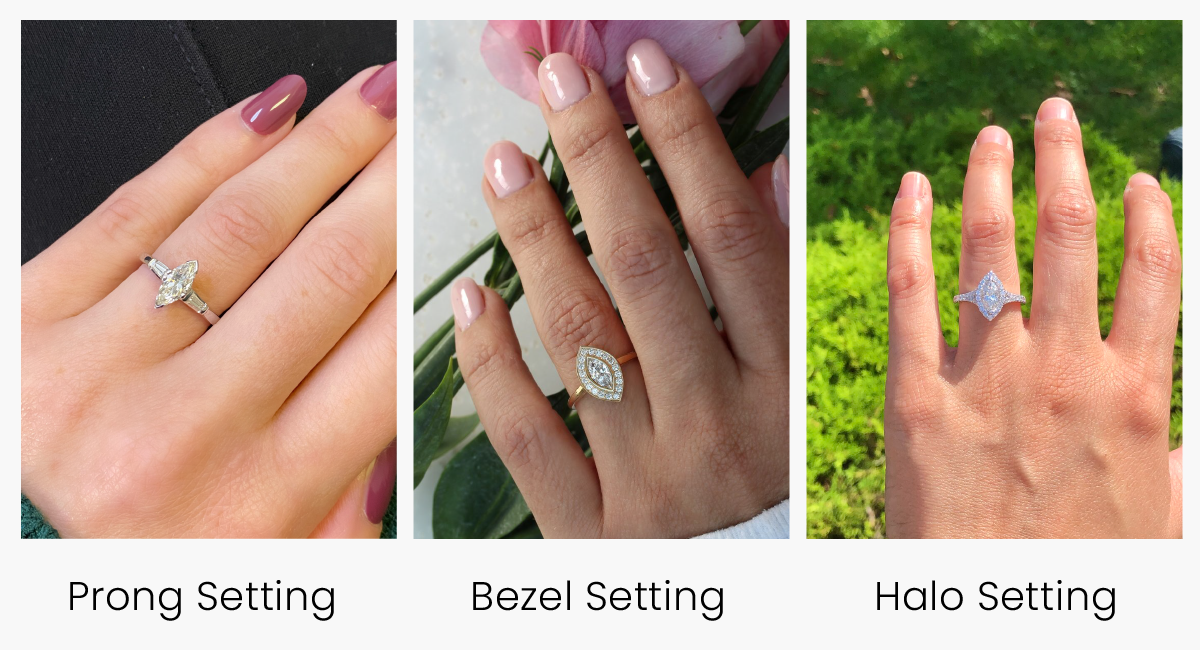
For marquise rings, the main impact is contrary to the regular. Hence for a marquise cut diamond ring, the most preferred setting is the halo, as the outline is highlighted with smaller diamonds, which enhances the shape and style of the marquise diamond. It tends to enhance the size and brilliance of the central marquise cut diamond. It is also an essential factor in the safety of the center diamond.
There is the prong setting, which ensures the absolute safety of the pointed ends of the marquise cut. In this setting, the body is held together by 6 prongs, and the points are either covered by prongs or v-shaped prongs, to keep the point from being harmed. This ensures the safety of the tip of the marquise cut diamond.
The prong setting is absolutely preferable if the wearer is looking for maximum brilliance. Since the prong setting allows for light to enter the stone from all directions, the brilliance that this setting provides is unmatched.
Can I Customize Rings When Purchasing From LGD?
LGD recognizes the value of tailoring our services according to each customer. We offer a seamless customization experience, allowing you to design your rings to perfection.
You can choose the metal type, diamond shape, carat weight, ring size, and other details to create a customized ring that suits your preferences and budget. Check out the “Printable Ring Size Chart” guide for measuring ring sizes.
Our experts will walk you through every step of the process, from picking the perfect diamond cut to selecting the metal for your piece of jewelry, so that it perfectly captures your personal taste and style.
Where Should I Buy Pear and Marquise Cut Diamonds From?
Look no further as we at Loose Grown Diamonds have in stock top-tier marquise and pear cut diamonds. As specialists in lab diamonds, we prioritize ethical sourcing and transparency.
Our marquise lab grown diamonds start at an affordable $650, while pear diamonds are available from just $450, offering diverse options for various preferences and your budgets, providing GIA/ GCAL and IGI certification for authenticity.
Utilize our exclusive discount promo code at checkout to enjoy an extra off. Trust LGD for superior marquise and pear cut diamonds. Adorning these magnificent vintage cuts is beautiful in every way. For the diamond cut as well as the wearer. Find your perfect lab grown diamond and its cut. Find the sweet spot between polished minimalism and bold individuality to take your look to the next level.
Conclusion
The pear and marquise cuts are both elegant and beautiful pieces of diamond. The settings in which they are held play an important role in their safety and beauty. The right kind of setting, metal, and also the perfect cut, can enhance the beauty of the diamond drastically. The brilliance of both cuts is stunning.
Since the diamonds are natural, they do possess certain mishaps and discolorations, while doing the cut. But these are minimized in lab-grown diamonds. Although not a real diamond, they do possess similar qualities as the natural diamond itself.
FAQs
What does a pear diamond look like?
A pear cut diamond exhibits a teardrop shape, symbolizing sensitivity and romance.
What is the most flattering diamond cut?
The most flattering diamond cut depends on personal preference; however, pear and marquise cuts are renowned for their elongating effect.
Why not buy a pear shaped diamond?
Careful handling is essential due to the delicate tip of pear cut diamonds.
Is a pear cut diamond more expensive?
The price of a pear-cut diamond varies based on factors like carat weight and quality.
Why do people like pear cut diamonds?
People are drawn to pear cut diamonds for their unique combination of round brilliant and marquise cuts, symbolizing romance.
Which diamond shape is most affordable?
Prices fluctuate, but pear shaped diamonds often come at a more affordable price than round brilliants.

